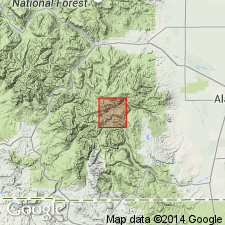
- Usage in publication:
-
- Piedra formation
- Modifications:
-
- Areal extent
- AAPG geologic province:
-
- San Juan basin
- San Juan Mountains province
- San Luis basin
Summary:
(E.S. Larsen's 1917 provisional and field names for Summitville quadrangle), p. 20, 36. Piedra formation. Top formation of Potosi volcanic series. In Platoro-Summitville district is overlain by Fisher quartz latite and underlain by Huerto formation. [Age is Miocene.]
Source: US geologic names lexicon (USGS Bull. 896, p. 1656).
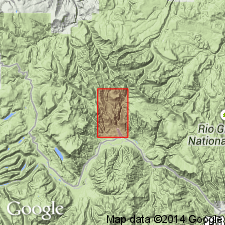
- Usage in publication:
-
- Piedra formation*
- Piedra group*
- Modifications:
-
- Principal ference
- Revised
- AAPG geologic province:
-
- San Juan Mountains province
- San Luis basin
Summary:
In Platoro-Summitville district, [Conejos and Rio Grande Counties, southwestern Colorado], the Piedra formation consists of 0 to 2,000+ feet of volcanic flows with subordinate tuff, predominantly of rhyolite and quartz latite, and is unconformably on Huerto formation. In Creede district, [northwest of Platoro-Summitville district, in Mineral County, southwestern Colorado], the Piedra becomes a group, divided into 8 or 9 formations, and in unconformably overlain by Creede formation and unconformably underlain by Alboroto group, the intervening Huerto formation being absent there. [Age is Miocene.]
Named from exposures in Piedra Peak, San Cristobal quadrangle, southwestern CO.
Source: US geologic names lexicon (USGS Bull. 896, p. 1656).
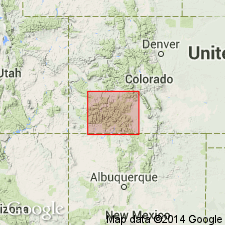
- Usage in publication:
-
- Piedra rhyolite*
- Modifications:
-
- Redefined
- Dominant lithology:
-
- Rhyolite
- Quartz latite
- AAPG geologic province:
-
- Piceance basin
- San Juan Mountains province
- San Luis basin
Summary:
[Credited to Larsen.] Changed name to Piedra rhyolite. [Age is Miocene.]
Source: US geologic names lexicon (USGS Bull. 896, p. 1656).
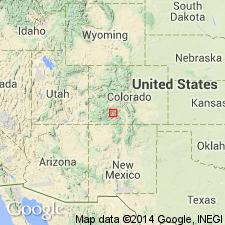
- Usage in publication:
-
- Piedra Group
- Modifications:
-
- Not used
Summary:
Includes units widely scattered within the revised volcanic sequence as determined by authors. Name not used in this report.
Source: GNU records (USGS DDS-6; Denver GNULEX).
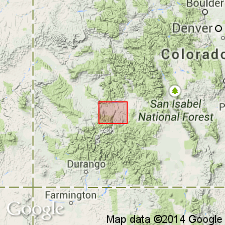
- Usage in publication:
-
- Piedra Rhyolite
- Modifications:
-
- Not used
Summary:
Ash-flow tuffs of Tertiary age formerly assigned to Piedra Rhyolite of Potosi Volcanic Series in Montrose Co in Paradox basin and in Gunnison Co in Piceance basin reassigned in this report to a newly named formation, Carpenter Ridge Tuff. Terms Piedra and Potosi not abandoned; they are not used.
Source: GNU records (USGS DDS-6; Denver GNULEX).
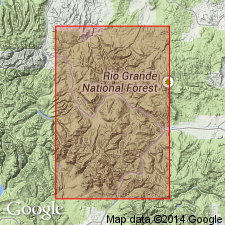
- Usage in publication:
-
- Piedra Rhyolite†
- Modifications:
-
- Abandoned
- AAPG geologic province:
-
- San Luis basin
Summary:
Pg. A36-A37, A79. †Piedra Rhyolite of Potosi Volcanic Group. Piedra Rhyolite as defined by Larsen and Cross (1956) in the San Juan field (Platoro-Summitville area, Rio Grande County, Colorado) is herein abandoned; replaced with Carpenter Ridge Tuff. Potosi Volcanic Group with other named formations remains in good usage outside report area. Larsen and Cross (1956) divided their Piedra into 4 informal members -3 silicic lava flow units and a tuff unit near the top of the volcanic succession. They correlated the lower part of the Bachelor Mountain Tuff (intracaldera equivalent of the Carpenter Ridge Tuff) and at least 2 other thick intracaldera accumulations with the older Alboroto Rhyolite. Recent work has shown that all 6 units are ash-flow tuffs and that each sheet had its source in a separate caldera. Inasmuch as Larsen and Cross recognized that their Piedra Rhyolite consisted of several units, it seems unwarranted to restrict this name to anyone of these --and particularly to one whose position in their sequence is especially uncertain. Therefore the name Piedra is herein abandoned. Authors propose that Carpenter Ridge Tuff (of Olson and others, 1968, p. C23-C26) be applied to the whole ash-flow sheet derived from the Bachelor caldera.
Source: Publication; supplemental areal extent information from GNU records (USGS DDS-6; Denver GNULEX).
For more information, please contact Nancy Stamm, Geologic Names Committee Secretary.
Asterisk (*) indicates published by U.S. Geological Survey authors.
"No current usage" (†) implies that a name has been abandoned or has fallen into disuse. Former usage and, if known, replacement name given in parentheses ( ).
Slash (/) indicates name conflicts with nomenclatural guidelines (CSN, 1933; ACSN, 1961, 1970; NACSN, 1983, 2005, 2021). May be explained within brackets ([ ]).

